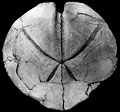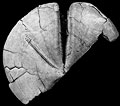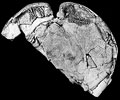The Echinoid Directory
Contributed by Andrew Smith, August 2011
Lambertona Sanchez Roig, 1953, p.
| Diagnostic Features |
|
|---|---|
| Distribution | Early Eocene, Cuba, Oligocene and Miocene of New Zealand |
| Name gender | feminine |
| Type | Victoriaster lamberti Sanchez Roig, 1924, p. 16, by original designation. |
| Species Included |
|
| Classification and/or Status | Spatangoida, Paleopneustina, Schizasteridae?
|
| Remarks | Kier (1984) revised this genus on the basis of the type species and demonstrated that it had only a peripetalous fasciole. Despite this he argued that it was a Schizasterid that had lost its latero-anal fasciole, like Abatus. Sanchez Roig, M. 1953. Dos nuevos generos de Equinoides cubanos: Lambertona y Neopatagus. Memorias de la Sociedad Cubana de Historia Natural "Felipe Poey" 21(3), 257-262, pls 27-29. Kier, P. M. 1984. Fossil spatangoid echinoids of Cuba. Smithsonian Contributions to Paleobiology 55, 1-336. |



